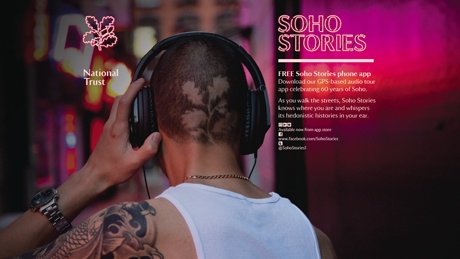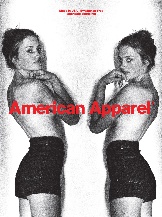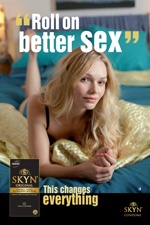Sex... does it still sell?
Debate over the use of sexual imagery in marketing has been reignited by – of all people – a ham maker and the National Trust. Lucy Handley looks at what counts as justified use of provocative advertising, as the regulator promises not to shy away from tightening up the rules.

Fashion houses have long used sexually provocative adverts to sell clothes, with the likes of American Apparel well known for their risqué images. But a wave of campaigns from some rather more unlikely hell-raisers are using bare flesh and innuendo to sell their products. Richmond Ham and the National Trust are two such brands attempting to get people hot under the collar.
Consumers’ reactions have varied widely. An ad for Kerry Foods’ Richmond Ham featuring naked farmers frolicking in luscious green fields is being investigated by the Advertising Standards Authority (ASA) for potentially breaching broadcast advertising codes mainly due to 350 complaints about bare bottoms being broadcast before the 9pm watershed.
Meanwhile, a New Look T-shirt showing a woman with a football between her legs was withdrawn from sale last month after complaints from customers on blogs and Facebook. And the National Trust, not generally known for its outrageousness, has launched an app giving a guided tour of Soho’s red light district to lure younger people to the brand, though only one person has officially complained that it is ‘glorifying the permissive society’ by doing so.
Marketers all want their brands to stand out, but treading the right side of the line can be tricky, especially when it comes to mass media such as outdoor advertising
Also a marketing case study is this year’s publishing phenomenon, Fifty Shades of Grey by the British author EL James. The book would suggest that sex still most definitely sells but its front cover downplays the content. The erotic novel has become the fastest-selling book in the UK with nearly 3 million print copies sold (see box) and 20 million worldwide.
But how do marketers judge how much sex they can use to sell their wares?
According to Jane Frost, chief executive at the Market Research Society, sex now sells if it is used in a clever and appropriate way.
Frost, a former senior marketer at the BBC and Shell, says: “Sex sells partly because it is about grabbing attention. Creating a communication that gets attention and engages with the audience is a key thing and if you need a bit of sex to do that, then fine.”
Whether a brand can get away with using sexual images in its products or advertising is also a matter of context, she says. The New Look T-shirt was visible to children aged 15 or under, which is an inappropriate place for it to be, so it was taken off sale.
“I don’t think it should have been there in the first place,” Frost says. “Unless a brand defines itself as smut – and plenty do, which are bought by a certain type of person – you don’t go to New Look with the expectation that you are going to find stuff like that.”
However, you also don’t go to the National Trust’s website in the expectation of finding an ‘X-rated Soho tour app’, as London’s Evening Standard described the charity’s initiative to attract under-40s to the brand.

Fig leaf or oak leaf? The National Trust has launched an app that guides users around Soho’s seedy side in a bid to recruit young members
The app, which talks through Soho’s history, including an account of being a stripper and descriptions of drug-taking, says Ivo Dawnay, the Trust’s director of London.
“It’s interesting how little shock there has been. The idea was not to go out and gratuitously shock people to try to show how funky the National Trust is, but you can’t tell the story of Soho in a completely ‘Songs of Praise’ way,” he says.
Most of the Trust’s membership is over 50, so the charity says it needs to appeal to younger people. The edgy app is just a prelude to a series of events to start later this summer.
Dawnay says: “What we are trying to do is tell a different story about the National Trust. We feel just as entitled to be working in the Soho environment as we are working on our own properties or estates.
“Soho has this some would say sleazy, some would say bohemian image, which relates to the image of London since the 18th century. People are much less prudish than they used to be. People are more relaxed about sex in all its forms and that is the contemporary way.”
Yet it can be difficult for brands to predict how consumers are going to react to their campaigns. The ad for Richmond Ham featuring naked people on a farm, and showing a bare bum, has been edited by owner Kerry Foods to cover up the offending part, after complaints were made.
A wave of campaigns from some rather more unlikely hell-raisers are using bare flesh and innuendo to sell their products
But the ad wasn’t meant to be edgy, says April Redmond, chief marketing officer at Kerry Foods. “The advert was designed to convey our core message about 100% natural ingredients in a light-hearted, tongue-in-cheek manner, using the tagline ‘as nature intended’.
“The decision to use nakedness in the ad was wholeheartedly innocent – after all, Richmond is a family brand.”
The ASA’s investigation into this campaign is ongoing, with a spokesman stressing that just because the body is looking into it doesn’t mean there is anything wrong with it. Indeed the regulator looks at advertising partly in relation to the ‘prevailing standards in society’.
However the ASA told Marketing Week in May that it would not be scared of tightening up its judgments. The regulator cites research that wanted it to be tougher when it comes to sexual imagery that children might see, in line with the conclusions of the Bailey review of the commercialisation and sexualisation of childhood.
ASA spokesman Matt Wilson says: “The Bailey review immediately puts this kind of issue at the top of the political agenda, as well as media and societal debates. Research has shown us that the public don’t have a problem with sexual imagery, but what they do want is a regulator to stop the free-for-all – to make sure that ads don’t go too far and don’t degrade or overtly sexualise.”
The ASA’s own research, done with parents and young people just before the government commissioned the review by Reg Bailey, chief executive of the Mothers’ Union, shows that people want a slightly tougher line, especially when it comes to imagery in less targeted media, such as outdoor posters.
“We are in a different place now to where we were pre-Bailey,” says Wilson. “You could argue that ads that were likely to be acceptable two or three years ago are not now.”

American Apparel uses ‘non-models’
The ASA banned eight online ads by American Apparel in April for ‘gratuitous nudity’. The retailer is known for using ‘real’ people in its advertising, who could be customers or floor staff.
Ryan Holiday, director of marketing at the retailer, says of the use of non-models: “The idea is not to embody some unattainable ideal, but to make great cotton and fashionable basics. By not using supermodels or celebrities, we can do it honestly and affordably.”
While Holiday won’t comment on the banned ads, he says: “American Apparel ads aren’t any more sexual than other fashion companies. I think it’s the fact that we use real models and don’t rely on Photoshop or professional makeup artists that make the ads seem somehow different than what else is out there. The fact that American Apparel ads are more realistic shouldn’t count against the company.”
However, the ASA disagreed, saying that using amateur models in suggestive poses made the ads seem exploitative to women.
Marketers all want their brands to stand out, but treading the right side of the line can be tricky, especially when it comes to mass media such as outdoor advertising.
Ansell Healthcare was investigated by the ASA earlier this year for posters advertising its Skyn condoms. The objections were to advertising that may have been seen by children, but as it wasn’t placed near schools the complaints were not upheld.

Rubber stamped: Skyn’s campaign was aimed at both male and female buyers of condoms, and complaints over UK ads were not upheld.
The brand launched its products in 22 countries earlier this year, using billboards with women in underwear proclaiming ‘roll on better sex’, and buying up football-pitch sized poster sites in places including Warsaw, to get its message across.
But the company claims that it was careful to make sure that the posters appealed to both men and women, given that 40 per cent of condom-buyers are now women, up from 20 per cent five years ago (see box).
Barry McCool, head of global marketing for the consumer division of Ansell, says the balance is sometimes difficult to strike. He adds: “Here is a case where we seem to have got it right, particularly because it is more disruptive coming from the female angle. In a world of cluttered condom advertising, a key learning for me is how you stand out when you are up against the big boys like Durex.”
Ansell is preparing the second wave of the campaign, to run as posters in seven UK cities in September, as well as Facebook promotions, online banners and in-store promotions.
McCool points out that most of the complaints have been about poster advertising, which could be seen by a broader audience than a targeted online ad, for example. And Frost at the Market Research Society agrees that when an ad is viewed by the target audience in the right context, it is more likely to hit its mark and avoid any offence or backlash.
The fine line between acceptable sexual imagery and smuttiness can be difficult to judge. But the key to successfully using sex in advertising seems to be to show a little but not too much.
Case Study
Fifty Shades of Grey: letting others do the sex talk for you

It has been dubbed ‘Mummy porn’ – and praised for rescuing marriages. But what is certain is that Fifty Shades of Grey has become the fastest-selling novel in the UK.
People might pick up the book because they hope they are going to be titillated by the sex scenes they have heard about, the publisher Random House admits. But it has focused on it as a fiction phenomenon when marketing it, rather than using sex as a selling point.
Laurence Festal, deputy marketing director at Cornerstone Publishing, part of Random, says: “Our marketing has not been about sex at all, it has been about the discovery of a book that everyone is talking about.
“We took the book to a mainstream audience in a mainstream way. We have tried to replicate a recommendation. Very often you come to books when friends recommend them.
“There is nothing raunchy about our ads, we have just used packshots and a plain background. The book is quite classy and very discreet in a way.”
On billboards and online, the advertising uses the line: “Discover the book that 20 million people can’t stop talking about.”
Much of the marketing uses Twitter and Facebook. Vintage Books, also part of Random House, used social site Get Glue to help publicise the book in the US when it launched there, before its UK debut.
“We used social media as a research tool to start with and then we applied our findings to developing a UK strategy which also used social media,” Festal says. “We treated Twitter as a place where influencers and the chattering classes go, where things get started and where word of mouth starts.
“On Facebook, we wanted to create a hub where all the fans could congregate and not direct them but be part of their conversations and share information with them.”
Facebook is where people often congregate during and after reading the first book – Fifty Shades of Grey is the first part of a trilogy, followed by Fifty Shades Darker and Fifty Shades Free – and Twitter is often where people comment having read all of the series in quick succession.
Festal claims that 44 per cent of the followers of the official Fifty Shades Facebook page comment whenever the publisher posts an update – far higher than most pages. At the time of writing, it had more than 287,000 likes and about 114,000 people talking about it.
Using social media also gave Cornerstone an insight into who was reading the books to start with – mainly women aged 35 or over – which Festal says is information the publisher wouldn’t normally have.
This is partly to do with the fact that the rights to the book were bought from Australian independent digital publisher The Writer’s Coffee Shop, so there was already online chatter around the book before it was launched in the UK. The marketing campaign was created quickly to capitalise on the fact that the publisher thought the book was likely to be sought after.
Festal claims that most of the chat on forums has been about the book’s main characters and their romance, rather than the nature of the sex scenes in it.
“There is a real difference between what readers are saying, and the debates the press have gone into. The readers are very much talking about the characters and how they identify with them or not. They are interested in the relationship and in the US they will talk about the love story a lot. It is a certain type of love story but it is a love story.”
Q&A
Where using sex is justified: selling condoms

Barry McCool
Head of global marketing,consumer division
Ansell Healthcare
Marketing Week (MW): You launched the campaign for Skyn condoms in the UK in February featuring women in underwear. How did you make sure the ads had the right appeal for both women and men?
Barry McCool (BM): We wanted to be a little different. The inspiration came from a girl in one of our focus groups in Paris who said: ‘This [product] completely changed my sex life forever’, which is a pretty strong claim.
The reason it works so well is that women see themselves in it, being empowered by the new generation talking about sex. And men like to look at women who are also looking very empowered talking about sex.
MW: How did you avoid smuttiness?
BM: You want to stay classy. At the same time, we are selling condoms, so it has to also look relatively sexy. We shot many pictures and felt that some of them were too suggestive or bordering on downmarket – for us it was all about getting the right pose.
MW: Skyn has launched in 22 countries. How do attitudes and your ads vary in them?
BM: People’s views about sex generally have become more liberalised. However, we have to dial it up and down depending on the market.
For example, in Brazil, the attitude is the more the merrier. In India, where we have a 25% share of the market, we have to crop it a bit tighter so you can see less flesh. We even had advertising pulled in India last year.
A lot of media owners are still very traditional. Our strategy was to create impact, so we had a lot of billboards. But we had to go through 12 or 13 site owners [in UK] as they wouldn’t take condom advertising, including in the borough of Camden in North London.
MW: When you’ve had complaints or been told to take the campaign down, what has your response been?
BM: It is not just about the creative piece, but also the ability and conservative nature of some organisations that won’t carry it. London Underground approved the creative, but in Warsaw, the transit authority would not allow any condom advertising.
If we feel [the objection] is to do with our creative, we fight it. We had some high impact billboards in Warsaw and there were some consumer complaints. Those are automatically filed with national authorities, but we said ‘no we are not pulling down our advertising’ and we won it.
You will get the official complaints filed, but you will also get the chatter going on Facebook and Twitter, where you can see how polarised people’s views are.
Banned: The campaigns that crossed the line
Opium
The Yves Saint Laurent perfume advert starring naked model Sophie Dahl was banned in 2000, after it received nearly 1,000 complaints about her provocative pose. A TV ad for Opium also attracted complaints last year, showing a woman pointing to her inner elbow and running her finger down her forearm. The line ‘I am your addiction. I am Belle d’Opium’ was used. It was banned by the Advertising Standards Authority (ASA) for suggesting drug use.s
The British Safety Council
In 1995 the BSC produced a provocative leaflet featuring the Pope in a hard hat with the headline: ‘Thou shalt always wear a condom.’ The ASA upheld the 1,192 complaints.
Oasis
The Coca-Cola-owned soft drink ran a TV ad in 2008 showing a young woman and her boyfriend ‘Cactus Kid’ running away from home after the girl became pregnant. Thirty two complaints were made and were upheld because the ad could be seen to condone teenage pregnancy and for its innuendo.
Nightclub leaflets This year has seen two nightclub leaflets banned by the ASA. One was distributed around Aberdeen University campus encouraging people to ‘go home with a stranger’ and another delivered near Newcastle University advertised a Tequila night using sexual imagery and inviting people to ‘come and swallow’.
Jack Wills
Last year, 19 people complained about the upmarket teenage clothing retailer’s spring catalogue, showing men and women in various states of undress on a beach, kissing and removing each others clothing. The ASA concluded that: ‘The catalogue was sufficiently provocative as to present a risk to younger teenagers.’
Life Natural Cures
A leaflet advertising a supposed herbal penis-enlargement supplement and showing men and women having sex was banned by the ASA in January – partly because it was out of keeping with the home and garden catalogue with which it was distributed.
American Apparel
One person complained about nine ads for the US clothing brand and in April this year, eight of them were banned. They showed women’s breasts and buttocks and appeared on its website and in a free magazine. The ASA said these were ‘exploitative of women and inappropriately sexualised young women’.
Budweiser
‘Gentlemen, you were conceived on a night like tonight… Now get out there, great times are waiting,’ were the lines in a radio ad for the beer, which ran in December last year. Broadcast rules state that alcohol must not be linked to sexual success.









